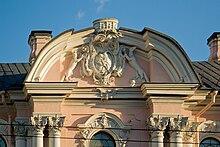Cranking

A cranked portion (particularly in older sources also offset ) is in the architecture of the leading around a horizontal Bauglieds (z. B. cornice , sleeve ring ) by a vertical wall projection (z. B. column and service as well as pillars or pilasters ). This creates a protruding edge, which is also known as the "bolster edge".
Terms
The technical term goes back to the meaning of "crooks" as "crooked bends". In addition to the standing term "cranked cornice", there is also talk of "cranked beams". It should be noted that the term entablature in architecture means different things that can also overlap with the terms of “cornice”.
- cornice
If a cornice does not jump horizontally around a protrusion, but in an arched manner, for example around a wall opening, one speaks of a "cranking" or "cranking".
- gable
A "cranked gable" is a gable in which the middle part steps forward or backward compared to the side parts. This does not make a statement about the gable shape (semicircular, segment arch-shaped, pointed).
Architectural history
Since Roman architecture , protruding, profiled cornices have been led around wall columns that protrude from the facade. In medieval church construction, too, crankings were used both on the outside and inside. Cranked cornices were of great importance as an element of facade design and structure in the Baroque era . This did not always correspond to later tastes. In 1771, for example, on the border between late baroque and classicism , Johann Georg Sulzer spoke in his general theory of the fine arts of the “breaking of an otherwise straight link”. He criticized:
“ You only see too often examples of this in new buildings. […] Not only are they, as already noted, completely inconsistent and contrary to the most essential rules, but they also give the buildings a very overloaded Gothic, or rather Arabic appearance; because the eye cannot just run away over an entablature, but bumps into Eken every moment. [...] It cannot be understood how it happens that one has not long since inhibited this effect of a spoiled taste. "
photos
Facade windows cranked by a bead
References and footnotes
- ↑ a b after cranking . In: Hans Koepf , Günther Binding : Picture Dictionary of Architecture (= Kröner's pocket edition . Volume 194). 4th, revised edition. Kröner, Stuttgart 2005, ISBN 3-520-19404-X .
- ↑ Sentence after cranked, cranked . In: Günther Wasmuth (Hrsg.): Wasmuths Lexikon der Baukunst . Berlin, 1929–1932 (4 volumes).
- ↑ after cranking [810]. In: Wilfried Koch: architectural style . 27th edition. Gütersloh / Munich 2006
- ↑ sentence after Giebel . In: Nikolaus Pevsner, Hugh Honor, John Fleming: Lexicon of World Architecture . 3. Edition. Prestel, Munich 1992. Comparable also with Giebel . In: Fritz Baumgart: DuMont's small subject dictionary of architecture . Cologne 1977.
- ↑ crank . In: Johann Georg Sulzer: General theory of the fine arts . 1771, zeno.org


